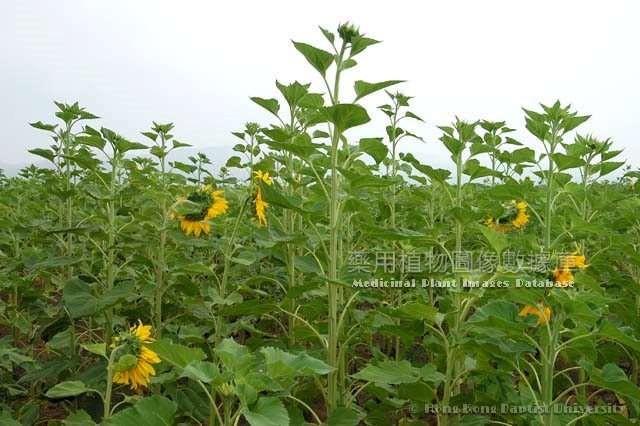|
|
|
Helianthus annuus L.

|
English Name |
Sunflower, Sun Flower, Common Garden Sunflower |
|
Latin name |
Helianthus annuus L. |
|
Family & Genus |
Asteraceae, Helianthus |
|
Description |
Annual herb, 1-3m tall. Stem thick and strong, upright, central medulla developed, covered by thick and hard hairs. leaf alternate, with long stipe; lamina cardioid ovate or broad ovate, 10-30cm long or longer, 8-25cm wide, anteriorly pointed, leaf base heart shaped or truncate, with 3 veins, both surfaces covered by thick and coarse hairs, margin with thick sawtooth. Capitulum, up to 35cm in diameter, solitary in stem end; phyllary ovate lanceolate or orbicularovate, anteriorly tail like gradually pointed, covered by long hard hairs; ligulate female flower, golden yellow, not solid; bisexual flower tubular, brown or purple, solid; receptacle even, membranous. Achene light grey or black, invert ovate or invert ovate long circular, slightly flat; pappus with 2 awns like scales, that fall off. Flowering: June to July. |
|
Distribution |
Cultivated in all parts of China. Originating in Americas. |
|
Part Used |
Medical part: roots, stem pith, leaves, flowers, flower disc, fruits and shell. Chinese name: roots: Xiangrikuigen. Stem pith: Xiangrikuijingsui. Leaves: Xiangrikuiye. Flowers: Xiangrikuihua. Flower disc: Xiangrikuihuapan. Fruits:Xinagrikuizi. |
|
Harvest & Processing |
Roots: excavated in summer and autumn, well washed, used fresh or sundried. Stem pith: collected in autumn, used fresh or sundried. Leaves: collected in summer and autumn, used fresh or sundried. Flower: collected in summer when flowering, used fresh or sundried. Flower disc: collected in summer when flowering, used fresh or sundried. Fruit: collected in autumn when fruits become mature, harvested flower disc, sundried, threshed down fruits, sun-dried again. |
|
Chemistry |
Root contains polysaccharides, helianthoside 2, etc. Stem contains chlorogenic acid, neochlorogenic acid and scopolin, etc. Leaves contain neochlorogenic acid, isochlorogenic, fumaric acid, camphor and luteolin, etc. Flower contains triterpenoid saponines, helianthoside A, B, C, etc. Seed contains fatty oil and organic acids, etc. |
|
Pharmacology |
Stem pith: immunity-strengthening. Leaves: anti-bacterial. Fruit: anti-cancer, and antioxidant. Flower disc: hypertension-reducing. |
|
Properties & Actions |
Root: sweet, tasteless, little cold. Stem core: sweet, neutral. Leaves: bitter, neutral. Flower: little sweet, neutral. Flower dish: sweet, cold. Fruits: sweet, neutral.Root: clearing heat, inducing urination, activating qi-flow and relieving pain. Stem pith: clearing heat, inducing urination and relieving cough. Leaf: reducing hypertension, anti-malaria and detoxifying. Flower: removing wind, regulating liver and inducing urination. Flower: removing wind, regulating liver and inducing urination. Flower disc: clearing heat, regulating liver, arresting bleeding and relieving pain. Fruit: promoting eruption, anti-malaria and promoting carbuncle pus. |
|
Indications & Usage |
Root: stranguria with turbid urine, edema, leukorrhea, hernia, gastric and abdominal swelling pain, injuries from falls. Stem pulp: stranguria with turbid urine, leucorrhea, albiduria, whooping cough, and bastard measles. Leaves: hypertension, malaria, furunculosis. Flower: dizziness, tinnitus, drenching and unsmooth urination. Floral disc: hypertension, headache, dizziness, tinnitus, stomachache, algomenorrhea, uterine bleeding, herpes. Fruits: unrelieved macular eruption, hematodiarrhoea, chronic osteomyelitis.Root: oral administration: decocting, 9-15g, double dose for fresh use, or powdered. External application: appropriate amount, triturated for application. Stem pith: oral administration: decocting, 9-15g. Leaf: oral administration: decocting 25-30g, double dose for fresh use. External application: appropriate amount, triturated for application. Flower: oral administration: decocting, 15-30g. Flower disc: oral administration: decocting, 15-60g, external application: appropriate amount, triturated for application or powdered for application. Fruit: oral administration: 15-30g, triturated or stewed with boiling water, external application: appropriate amount, triturated for application or extracted oil for application. |
|
Examples |
1. Infantile measles not erupted sufficiently: sunflower seed 1 small liquor cup, and pestle into pieces. Swallow with boiled water.
2. Dripping discharge of urine: sunflower 1 bundle. Decoct in water and boil for 5-7 times, drink.
3. Renal deficiency and tinnitus: sunflower floral disc 15g, Gold theragran, prepared rhizome of rehmannia 9g each. Decoct in water and swallow.
4. Hypertension: sunflower leaves 31g, tuachyranthis radix 31g. Decoct in water and swallow.
5. Stranguria: sunflower stem marrow 30g, plantain, common rush 15g each, pale bamboo leaves 9g. Decoct and swallow.
6. Puffiness: sunflower root, white gourd peel or leaves in equal amounts. Bake dry and grind into a powder, prepare pills with rice wine. 3 times a day, 10g each time, take consecutively for 5 days. |
|
Permanent URL:https://sys01.lib.hkbu.edu.hk/cmed/mpid/detail.php?herb_id=D00691 |
|
|
|

